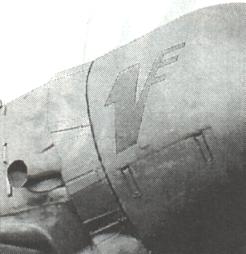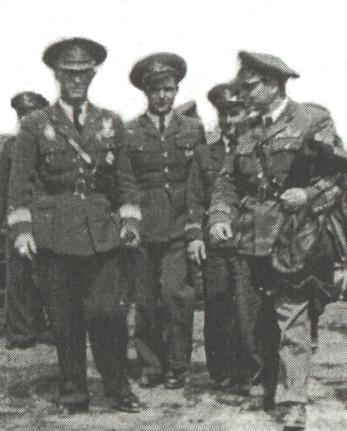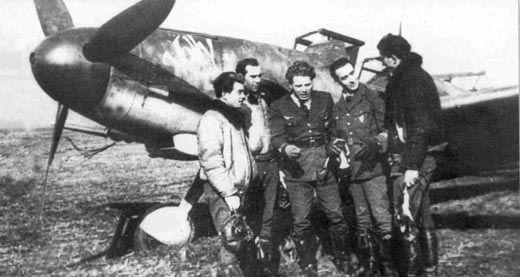|

Picture from "Vanatorul IAR-80, istoria unui erou necunoscut" by
Dan Antoniu & George Cicos, MODELISM, 2000
The emblem of the 1st Fighter Group on the cowling of an IAR-80
On 25 October 1939 the 2nd Fighter Flotilla was created. It consisted of the 1st
and 4th Fighter Group.
The 1st Fighter Group was commanded by lt. cdor. av. Govela and was equipped with 20 P.11fs,
divided between the 41st and 42nd Squadron. On 18 December 1940 it moved on the Floresti
airfield.
In January 1941, 7 of the group's pilots were designated to start training on the IAR-80
and in June, the 1st Fighter Group became the 1st Training Group and moved to Turda in
Transylvania. This unit was suppose to prepare the future IAR-80 pilots. The PZL fighters
were assigned to the 3rd Fighter Flotilla.
On 1 July, the 41st Fighter Squadron, completely equipped with IAR-80s, joined the 8th
Fighter Group on the front. In August, the 42nd Squadron was joined with the badly hit 52nd
and formed the IAR equipped 42/52nd Fighter Squadron, which was also assigned to the 8th
Fighter Group.
In September 1943 the 1st Fighter Group was reactivated. It now had 3 squadrons: 55th,
63rd and 64th and was based on Targsorul Nou airfield, in Romania. In November it was
moved on the Rosiorii de Vede airfield, as part of the air defense of Bucharest and of the
Ploesti area. Also, the 43rd Squadron replaced the 55th. The group was put under the
command of cpt. cdor. av. Ioan Sandu.

Picture from "Vanatorul IAR-80, istoria unui erou necunoscut" by
Dan Antoniu & George Cicos, MODELISM, 2000
Cpt. cdor. av. Ioan Sandu with two of his squadron commanders: lt. av. Gulan and
cpt. av. Stefanescu
On 4 April 1944, took place the first raid of the US 15th Air Force over Romania. 24
IAR-80Cs of the 1st Fighter Group took off to intercept the bombers. As a result, the group
claimed 10 B-24s shot down, of which only 8 were confirmed. One of them belonged to the
unit's commander, cpt. cdor. av. Ioan Sandu. The group lost 1 airplane and another two crash landed.
Three pilots were wounded. One of them however managed to come back with his airplane to
base and make a safe landing.
The following day the Americans returned. The group scrambled 23 fighters. The 63rd and
64th Squadrons encountered only a lone B-24, which escaped in the clouds. Only the 43rd
manage to find a formation of about 30 B-24 and attacked them and shot down 3. During this
mission the American fighters also made their presence felt. Adj. av. Raghiga Dumitrescu was
engaged by four P-38s. He managed to fire on one of them and smoke started to come out of
the Lightning. He was attacked by the others and went down in flames. He was the first
pilot lost by the group. Another two airplanes crash landed and two pilots were wounded.
The next raid was 15 April. From the 1st Fighter Group 24 IAR-80Cs took off, but only a
celulă (Romanian for Rotte) from the 63rd Squadron stumbled upon an enemy formation.
The result was one B-24 shot down and one IAR-80 damaged. On 16 April there was another
raid, but the 25 of the group's fighters, which were scrambled, didn't encounter the
enemy.
On 21 April, the bombers of the 15th Air Force returned this time with a powerful fighter
cover. From the 1st Fighter Group, 26 airplanes took off at 11:20. A patrulă
(Romanian for Schwarm) from the 43rd Squadron encountered about 30 unescorted B-24s,
attacked and shot down 2. Another patrulă, however, was surprised by Mustangs
from the 31st Fighter Group as they were coming out of the clouds and all four were
shot down. A third patrulă attacked a B-24 which was separated from the
bomber formation and probably shot it down. The 63rd Squadron attacked also a bomber
formation, but lost it in the clouds. The airplanes got separated during their attempt to
follow the B-24s and soon were attacked by P-38s. The day was a regular carnage for the
1st Fighter Group: 5 pilots killed, 2 wounded and 6 airplanes destroyed and another
4 damaged.

Profile courtesy of
Bogdan Patrascu
This IAR-80B was later equipped with two Mauser 20 mm cannons and
assigned to the 1st Fighter Group in 1944
Three days later, another raid took place. 16 IARs from the 1st Fighter Group were
sent to meet the bombers. A patrulă from the 43rd Squadron encountered about
150 B-24s and attempted to attack them, but were themselves attacked by P-51s and had to
flee. Adj. av. Constantin Popescu remained behind his comrades and stumbled upon a
formation 40 B-24s. He surprised them and downed three. A formation from the 63rd Squadron
spotted a lone P-38, which they probably shot down. Only one of the group's IAR-80C was
damaged.
On 5 May, the 1st Fighter Group scrambled 19 airplanes to meet the attackers. They
encountered a large formation of B-24s, escorted by 80-90 fighters, and engaged them.
Nine Liberators were claimed shot down, but eight were later confirmed. The group suffered
no casualties. The next day, the 15 IAR-80Cs, which took off to intercept the American
formations, claimed 7 aircraft, 5 bombers and two P-38s. One Romanian pilot was wounded.
Their luck changed on 7 May. Only one B-24 was shot down by adj. av. Dumitru Chera. The
group had one wounded pilot and 3 damaged aircraft.
The next raid was 18 May, when 19 IARs from the 1st Fighter Group took off to engage the
bombers of the 15th Air Force. The entire group attacked a formation of B-17s and shot down
two of them. The patrulă under the command of lt. av. Ioan Micu (one of the aces of the
1941 campaign) was attacked by 12 Lightnings and, in the following dogfight, the Romanian
ace downed one P-38. The same day, slt. av. Gheorghe Cristea was lost.
On 31 May, the group sent his dwindling forces to engage the incoming bombers. Two were
shot down, but two pilots were killed in action. Only 16 airplanes remained available.
These took off on 6 June and intercepted an American formation and shot one B-24 and one
B-17. The latter, however, remained unconfirmed. Two Romanian fighters were damaged, but
were repairable. Four days later, the 15 IARs of the 1st Fighter Group didn't encounter
the enemy. The next day the group only scored one victory (a B-17), but suffered no
losses.
Until 23 June, the date of the next American raid, the number of available aircraft
in the 1st Fighter Group increased. So 19 fighters were scrambled against the B-17
formations. Two were shot down, but the Mustangs took a heavy toll among the Romanian
pilots. Two were killed and another three crash landed. Among those killed was the group's
commander, cpt. cdor. av. Ioan Sandu. The next day, the remaining 17 IAR-80Cs attacked once again the
B-17s, but without results.
On 28 June, the 1st Fighter Group scrambled its 17 IARs and intercepted a bomber
formation and attacked it, while trying to avoid the Mustangs. Three B-17s were shot down.
Also, adj. av. Zisu Sava claimed a P-51, which remained probable. This is the only case when a
IAR-80 pilot claimed a Mustang. The group lost cpt. av. Stefanescu and adj. av. Prasinopol was
wounded.
This was the last battle with USAAF. A part of the 1st Fighter Group's pilots and
airplanes were assigned to the 6th Fighter Group. At the end of July, the group started
to train in order to convert to the Bf-109G.
During the winter of 1944/45 the group was reorganized. It had only two squadrons: the
61st and 64th. It was put under the command of cpt. av. Dan Vizanti, the former commander of the
6th Fighter Group. This new group was sent to the front in Slovakia in early 1945, where
it was suppose to help the exhausted 9th Fighter Group. The first missions were flown on 20
February. The lack of experience on the Bf-109G among most of the group's members was
obvious and soon they were diverted to air support missions. Anyway, after 25, Luftwaffe
didn't appear in the area, except for several reconnaissance flights. The only "casualties"
suffered by the 1st Fighter Group during this last campaign were two pilots that defected
on 26 March to a German air base.

Picture from "Rumanian Air Force, the prime decade 1938-1947" by
Dénes Bernád, Squadron/Signal Publications, 1999
Pilots from the 1st Fighter Group on the front in Czechoslovakia
After the war, several Romanian pilots reportedly took part in a large Allied-organized
air show at Wiener-Neustadt on 1 June 1945. These airmen were asked to represent the German
techniques and equipment, including the Bf-109G6, and provide a comparison to the latest
US and Soviet aircraft types. On the way back to Miskolc, two pilots from the 1st Fighter
Group, of. echip. cls. III Ion Milu and lt. av. Dumitru Baciu met several P-51Ds over
Hungary and waggled their wings as a recognition sign. The Mustangs waved back when the
aircraft passed each other. A Soviet Il-2 formation, escorted by Yak-3s, came along a few
minutes later. The Romanians again waggled their wings, however, the Soviets did not wave
back and flew on in the opposite direction. The last two Yaks suddenly broke formation and
jumped on the two "Gustavs". Milu had enough of the war (five years and 45 confirmed
victories) and decided not to engage the aggressors. So he dived to safety. Lt. av. Baciu
apparently managed to shoot down one Soviet and returned home with 16 holes in his
aircraft. This is probably the last victory achieved by a Romanian fighter pilot. |